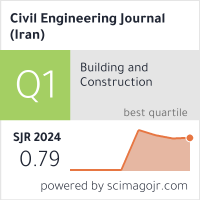Modeling the Compressive Strength of Metakaolin-Based Self-Healing Geopolymer Concrete Using Machine Learning Models
Downloads
Doi:10.28991/CEJ-2025-011-04-020
Full Text:PDF
Downloads
[2] Shaikh, F. U. A. (2016). Mechanical and durability properties of fly ash geopolymer concrete containing recycled coarse aggregates. International Journal of Sustainable Built Environment, 5(2), 277–287. doi:10.1016/j.ijsbe.2016.05.009.
[3] Shamim Ansari, S., Muhammad Ibrahim, S., & Danish Hasan, S. (2023). Conventional and Ensemble Machine Learning Models to Predict the Compressive Strength of Fly Ash Based Geopolymer Concrete. In Materials Today: Proceedings, 1-8. doi:10.1016/j.matpr.2023.04.393.
[4] Abdel-Gawwad, H. A., & Abo-El-Enein, S. A. (2016). A novel method to produce dry geopolymer cement powder. HBRC Journal, 12(1), 13–24. doi:10.1016/j.hbrcj.2014.06.008.
[5] Khan, K., Ahmad, W., Amin, M. N., & Deifalla, A. F. (2023). Investigating the feasibility of using waste eggshells in cement-based materials for sustainable construction. Journal of Materials Research and Technology, 23, 4059–4074. doi:10.1016/j.jmrt.2023.02.057.
[6] Liu, T., Nafees, A., khan, S., Javed, M. F., Aslam, F., Alabduljabbar, H., Xiong, J. J., Ijaz Khan, M., & Malik, M. Y. (2022). Comparative study of mechanical properties between irradiated and regular plastic waste as a replacement of cement and fine aggregate for manufacturing of green concrete. Ain Shams Engineering Journal, 13(2), 101563. doi:10.1016/j.asej.2021.08.006.
[7] Pratap, B., Sharma, S., Kumari, P., & Raj, S. (2024). Mechanical properties prediction of metakaolin and fly ash - based geopolymer concrete using SVR. Journal of Building Pathology and Rehabilitation, 9(1), 1. doi:10.1007/s41024-023-00360-9.
[8] Wang, R., Zhang, J., Lu, Y., Ren, S., & Huang, J. (2024). Towards a Reliable Design of Geopolymer Concrete for Green Landscapes: A Comparative Study of Tree-Based and Regression-Based Models. Buildings, 14(3), 615. doi:10.3390/buildings14030615.
[9] Wang, Y., Iqtidar, A., Amin, M. N., Nazar, S., Hassan, A. M., & Ali, M. (2024). Predictive modelling of compressive strength of fly ash and ground granulated blast furnace slag based geopolymer concrete using machine learning techniques. Case Studies in Construction Materials, 20, 3130. doi:10.1016/j.cscm.2024.e03130.
[10] Tian, Q., Su, Z., Fiorentini, N., Zhou, J., Luo, H., Lu, Y., Xu, X., Chen, C., & Huang, J. (2024). Ensemble learning models to predict the compressive strength of geopolymer concrete: a comparative study for geopolymer composition design. Multiscale and Multidisciplinary Modeling, Experiments and Design, 7(3), 1793–1806. doi:10.1007/s41939-023-00303-4.
[11] Ahmed, H. U., Abdalla, A. A., Mohammed, A. S., Mohammed, A. A., & Mosavi, A. (2022). Statistical Methods for Modeling the Compressive Strength of Geopolymer Mortar. Materials, 15(5), 1868. doi:10.3390/ma15051868.
[12] Mansouri, E., Manfredi, M., & Hu, J. W. (2022). Environmentally Friendly Concrete Compressive Strength Prediction Using Hybrid Machine Learning. Sustainability (Switzerland), 14(20), 12990. doi:10.3390/su142012990.
[13] Ebid, A. E., Deifalla, A. F., & Onyelowe, K. C. (2024). Data Utilization and Partitioning for Machine Learning Applications in Civil Engineering. Sustainable Civil Infrastructures, 87–100. doi:10.1007/978-3-031-70992-0_8.
[14] Hoffman, F. O., & Gardner, R. H. (1983). Evaluation of uncertainties in radiological assessment models. In J. E. Till & H. R. Meyer (Eds.), Radiological Assessment: A Textbook on Environmental Dose Analysis. NRC Office of Nuclear Reactor Regulation, San Diego, United States.
[15] Siddique, R., Aggarwal, P., & Aggarwal, Y. (2011). Prediction of compressive strength of self-compacting concrete containing bottom ash using artificial neural networks. Advances in Engineering Software, 42(10), 780–786. doi:10.1016/j.advengsoft.2011.05.016.
[16] Singh, P., Bhardwaj, S., Dixit, S., Shaw, R. N., & Ghosh, A. (2021). Development of prediction models to determine compressive strength and workability of sustainable concrete with ann. Lecture Notes in Electrical Engineering: Vol. 756 LNEE, 753–769. doi:10.1007/978-981-16-0749-3_59.
[17] Song, H., Ahmad, A., Farooq, F., Ostrowski, K. A., MaŠ›lak, M., Czarnecki, S., & Aslam, F. (2021). Predicting the compressive strength of concrete with fly ash admixture using machine learning algorithms. Construction and Building Materials, 308, 125021. doi:10.1016/j.conbuildmat.2021.125021.
[18] Song, Y., Zhao, J., Ostrowski, K. A., Javed, M. F., Ahmad, A., Khan, M. I., Aslam, F., & Kinasz, R. (2022). Prediction of compressive strength of fly-ash-based concrete using ensemble and non-ensemble supervised machine-learning approaches. In Applied Sciences (Switzerland), 12(1), 361. doi:10.3390/app12010361.
[19] Topçu, I. B., & Saridemir, M. (2008). Prediction of compressive strength of concrete containing fly ash using artificial neural networks and fuzzy logic. Computational Materials Science, 41(3), 305–311. doi:10.1016/j.commatsci.2007.04.009.
[20] Zhang, J., Zhao, Y., & Li, H. (2017). Experimental Investigation and Prediction of Compressive Strength of Ultra-High Performance Concrete Containing Supplementary Cementitious Materials. Advances in Materials Science and Engineering, 4563164. doi:10.1155/2017/4563164.
[21] Yilmaz, S., & Küçüksille, E. U. (2015). A new modification approach on bat algorithm for solving optimization problems. Applied Soft Computing Journal, 28, 259–275. doi:10.1016/j.asoc.2014.11.029.
[22] Chiroma, H., Herawan, T., Fister, I., Fister, I., Abdulkareem, S., Shuib, L., Hamza, M. F., Saadi, Y., & Abubakar, A. (2017). Bio-inspired computation: Recent development on the modifications of the cuckoo search algorithm. Applied Soft Computing Journal, 61, 149–173. doi:10.1016/j.asoc.2017.07.053.
[23] Onyelowe, K. C., Ebid, A. M., Aneke, F. I., & Nwobia, L. I. (2023). Different AI Predictive Models for Pavement Subgrade Stiffness and Resilient Deformation of Geopolymer Cement-Treated Lateritic Soil with Ordinary Cement Addition. International Journal of Pavement Research and Technology, 16(5), 1113–1134. doi:10.1007/s42947-022-00185-8.
[24] Mohamad, A. B., Zain, A. M., & Bazin, N. E. N. (2014). Cuckoo search algorithm for optimization problems - A literature review and its applications. Applied Artificial Intelligence, 28(5), 419–448. doi:10.1080/08839514.2014.904599.
[25] Onyelowe, K. C., Ebid, A. M., & Hanandeh, S. (2024). Advanced machine learning prediction of the unconfined compressive strength of geopolymer cement reconstituted granular sand for road and liner construction applications. Asian Journal of Civil Engineering, 25(1), 1027–1041. doi:10.1007/s42107-023-00829-5.
[26] Al-Kharabsheh, B. N., Arbili, M. M., Majdi, A., Alogla, S. M., Hakamy, A., Ahmad, J., & Deifalla, A. F. (2023). Basalt Fiber Reinforced Concrete: A Compressive Review on Durability Aspects. Materials, 16(1), 429. doi:10.3390/ma16010429.
- Authors retain all copyrights. It is noticeable that authors will not be forced to sign any copyright transfer agreements.
- This work (including HTML and PDF Files) is licensed under a Creative Commons Attribution 4.0 International License.![]()















